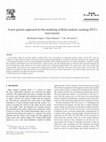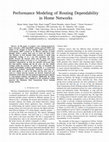Papers by vineet srivastava

Chemical Engineering Science, 2007
A new kinetic model for the fluid catalytic cracking (FCC) riser is developed. An elementary reac... more A new kinetic model for the fluid catalytic cracking (FCC) riser is developed. An elementary reaction scheme, for the FCC, based on cracking of a large number of lumps in the form of narrow boiling pseudocomponents is proposed. The kinetic parameters are estimated using a semi-empirical approach based on normal probability distribution. The correlation proposed for the kinetic parameters' estimation contains four parameters that depend on the feed characteristics, catalyst activity, and coke forming tendency of the feed. This approach eliminates the need of determining a large number of rate constants required for conventional lumped models. The model seems to be more versatile than existing models and opens up a new dimension for making generic models suitable for the analysis and control studies of FCC units. The model also incorporates catalyst deactivation and two-phase flow in the riser reactor. Predictions of the model compare well with the yield pattern of industrial scale plant data reported in literature. ᭧

Queueing theory and communication theory ideas are jointly applied to relate a communication link... more Queueing theory and communication theory ideas are jointly applied to relate a communication link's bandwidth and the physical layer processing to a metric called permissible arrival rate. Permissible arrival rate is defined as the traffic in packets/sec that the link can support under an average delay constraint. Simple conditions that highlight the impact of changing physical layer processing on the permissible arrival rate are developed. The results are interpreted in the context of a frequency division multiple access (FDMA) based wireless ad-hoc network. For fixed transmitted power and physical layer processing, the permissible arrival rate initially increases with link bandwidth. However, loss of signal-to-noise ratio and increased interference due to higher bandwidth eventually cause the permissible arrival rate to diminish. The results are illustrated by means of numerical examples and discrete event simulations.
Of late, there has been an avalanche of cross-layer design proposals for wireless networks. A num... more Of late, there has been an avalanche of cross-layer design proposals for wireless networks. A number of researchers have looked at specific aspects of the network performance and, by approaching cross-layer design as per their interpretation of what it implies, presented several cross-layer design proposals involving different layers of the protocol stack. There have also been works relating to the

In this paper, we propose a new routing protocol for home networks, called dependable routing pro... more In this paper, we propose a new routing protocol for home networks, called dependable routing protocol (DRP) that adapts to the changes in local topology within home networks environments. DRP is based on an effective selection of paths through which a packet must pass to reach the home unit. The selection, in such dynamic home networks, is made using dependable routing, i.e, in a way that maximizes the routes quality between the network nodes and the home unit while minimizing the Failure of Service (F oS). To minimize F oS, DRP maintains requirements on both the tolerable end-to-end delay (for time-sensitive routing) and the bit error rate (for reliable routing) within the network. To achieve this, we formulate the routing dependability problem mathematically as a constrained optimization problem. Specifically, analytical expressions for the route quality as well as the delay and bit error rate of a route in a home network scenario are derived. Numerical and simulation results show that the proposed approach gives optimal or near-optimal solutions and improves significantly the home network performance when compared to one prominent routing protocol: the Minimum Total Transmission Power Routing scheme, MTPR.
We present practical algorithms for the soft demapping of dual-carrier modulated (DCM) symbols. D... more We present practical algorithms for the soft demapping of dual-carrier modulated (DCM) symbols. DCM has been proposed in the recent multi-band orthogonal frequency division multiplexing (MB-OFDM) based ultra-wideband (UWB) systems for achieving high data rates (up to 480 Mb/s). The DCM constellation is essentially two closely coupled 16-QAM constellations. As such, we first look at a joint (or a 2D) demapping scheme, and then move on to look at a few ID demapping schemes whereby the two 16-QAM constellations are demapped individually. Our results show that a 2D demapping scheme which we term as the 2D-Max Log is the most attractive DCM demapping scheme from both implementation and performance viewpoints

Uploads
Papers by vineet srivastava